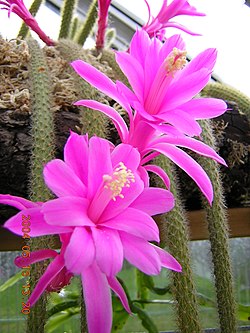| Aporocactus | |
|---|---|
 | |
| Aporocactus martianus | |
| Scientific classification | |
| Kingdom: | Plantae |
| Clade: | Tracheophytes |
| Clade: | Angiosperms |
| Clade: | Eudicots |
| Order: | Caryophyllales |
| Family: | Cactaceae |
| Subfamily: | Cactoideae |
| Tribe: | Hylocereeae |
| Genus: | Aporocactus Lem. |
| Species | |
Aporocactus is a genus of cacti in the tribe Hylocereeae native to Mexico. It used to be classified as a subgenus in Disocactus , but according to molecular evidence, it should be excluded from Disocactus and treated as a separate genus. [1] [2]

